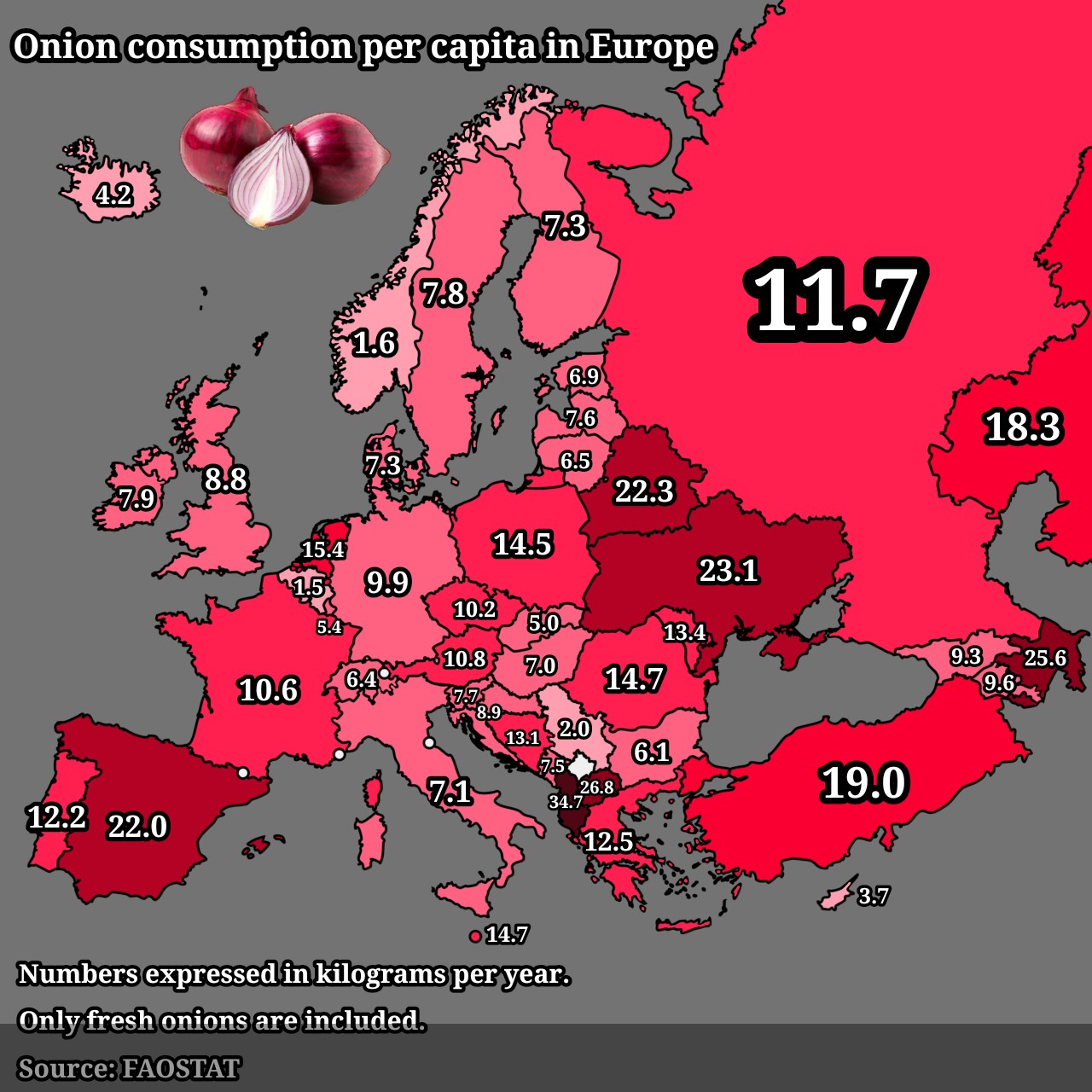Onion Consumption Per Capita in Europe Map


David Chen
Data Visualization Specialist
David Chen is an expert in transforming complex geographic datasets into compelling visual narratives. He combines his background in computer science ...
Geographic Analysis
What This Map Shows
The "Onion Consumption Per Capita in Europe Map" provides a visual representation of how much onions are consumed by individuals across various European countries. It highlights the differences in dietary habits and preferences related to this essential ingredient. This map reveals not just numbers, but also cultural attitudes towards onions, which have been a staple in European kitchens for centuries.
Deep Dive into Onion Consumption in Europe
Onions are one of the most widely used vegetables in culinary traditions around the world, and Europe is no exception. In fact, onions are often considered the backbone of many recipes, lending flavor and depth to countless dishes. But what drives the variations in onion consumption across different countries in Europe?
Interestingly, several factors contribute to these differences, including agricultural practices, local cuisines, and even climate conditions that affect onion cultivation. For instance, according to the latest data, countries like Turkey and Greece show some of the highest per capita onion consumption rates in Europe. This can be attributed to their Mediterranean diets, which frequently incorporate onions in salads, stews, and various traditional dishes.
In contrast, Northern European countries, such as Sweden and Norway, tend to have lower onion consumption rates. This may be due to their culinary preferences, which often lean towards more robust flavors from fish and root vegetables rather than the pungent sweetness that onions provide. Have you ever noticed how regional cuisines can significantly influence dietary habits?
Additionally, agricultural production plays a vital role in onion consumption. Countries that cultivate onions extensively, like Spain and the Netherlands, not only produce large quantities for export but also have a population accustomed to integrating onions into their daily meals. Spain, for example, has a rich tradition of using onions in its famous gazpacho and paella.
Another fascinating aspect is the nutritional value of onions, which is often overlooked. Onions are rich in vitamins, minerals, and antioxidants. They contain vitamin C, B vitamins, and various phytochemicals that contribute to overall health. This makes their consumption beneficial, not just for taste but also for nutrition, which may be influencing consumption trends among health-conscious consumers.
Regional Analysis
When examining the map, distinct patterns emerge across different European regions. Southern Europe, for example, showcases a higher per capita consumption of onions, with countries like Greece and Italy leading the way. This aligns with their culinary traditions that celebrate fresh, flavorful ingredients. Interestingly, Italy’s love for onions is evident in dishes like Cipolla di Tropea, a sweet red onion famed for its unique flavor.
In contrast, Central and Eastern European countries present a mixed picture. For instance, Poland and Hungary exhibit moderate levels of onion consumption, often using them in hearty dishes like goulash and bigos. However, these countries also balance their onion intake with other vegetables, leading to varied consumption figures.
Western Europe presents a more diverse landscape. Countries like France and the UK show a balanced approach to onion consumption, integrating them into a wide variety of dishes, from French onion soup to classic British onion gravy. Interestingly, urban areas in these countries tend to have higher consumption rates, possibly due to the influence of global cuisines and the availability of diverse ingredients in metropolitan settings.
Interestingly, the Nordic countries represent a unique case. Countries such as Finland and Denmark, while having lower overall onion consumption, often rely on them for specific seasonal dishes. This highlights how cultural practices can dictate not just what is eaten, but when it is enjoyed.
Significance and Impact
Understanding onion consumption patterns is not just an exercise in geography or culinary arts; it has real-world implications. For farmers and agricultural policymakers, knowing which countries have high demand for onions can inform planting strategies and export opportunities. As global food trends evolve, the demand for healthy, flavorful ingredients like onions is likely to rise, especially with the increasing focus on plant-based diets.
Moreover, the environmental impact of onion farming cannot be overlooked. Regions with high onion consumption may face challenges related to sustainable farming practices and water usage, especially as climate change continues to affect agricultural outputs across Europe. Future projections indicate that as dietary preferences shift, so too will the agricultural landscapes of Europe, making it essential to monitor these changes closely.
In summary, the "Onion Consumption Per Capita in Europe Map" not only highlights the varying rates of onion consumption across the continent but also encourages us to think about the broader implications of what we eat and how it reflects our cultural identities. Ever wondered how something as simple as an onion can tell us so much about a region's culinary heritage? The map serves as a reminder that food is more than just sustenance—it’s a mirror reflecting our diverse cultures and histories.
Visualization Details
- Published
- August 6, 2025
- Views
- 130
Comments
Loading comments...